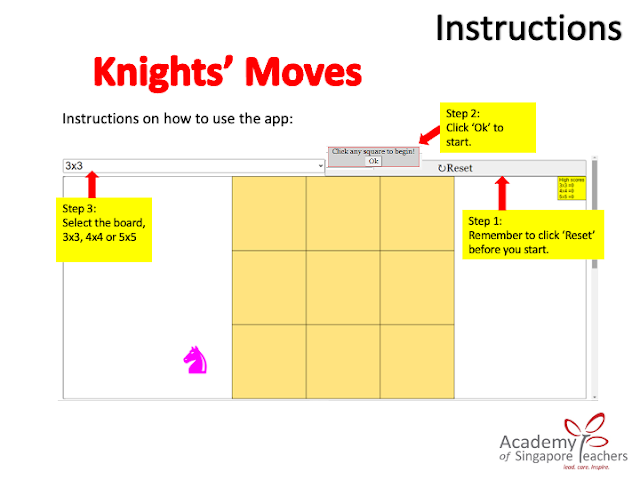Overview:
This briefing document summarizes the key themes and important aspects of the "Open Educational Resources / Open Source Physics @ Singapore" webpage, specifically focusing on the section titled "20210830 Digital E2K applications Knights Move." The page serves as a repository and showcase for a wide array of interactive digital resources, primarily simulations and applets, designed for educational purposes across various subjects, with a strong emphasis on Physics and Mathematics for primary and secondary levels. The content highlights the collaborative efforts of educators and specialists in Singapore to leverage open educational resources and open-source tools to enhance learning experiences.
Main Themes and Important Ideas:
- Focus on Interactive Digital Learning Resources: The core of the webpage is the extensive list of interactive simulations and applets. These resources cover a diverse range of topics within Physics (Newtonian Mechanics, Gravity, Quantum Spin, Diffraction, Rotational Motion, Optics, Electromagnetism, Thermodynamics), Mathematics (Fractions, Numbers, Geometry, Algebra, Functions, Data Analysis), and even other subjects like Chemistry, Biology, and English Language.
- Examples include: "🍎7.2 Gravitational Field JavaScript HTML5 Applet Simulation Model," "📊MAthematics PlaySpace Fractions Bar Model Interactive JavaScript Applet," "🌡️Adding Heat to Water, Melting and Boiling 2021 JavaScript HTML5 Applet Simulation Model," and "🐉Shoot the simile and metaphor dragons HTML5 game."
- Emphasis on Open Educational Resources (OER) and Open Source: The name of the website itself, "Open Educational Resources / Open Source Physics @ Singapore," underscores its commitment to freely accessible and modifiable educational materials. The content is licensed under the "Creative Commons Attribution-Share Alike 4.0 Singapore License," explicitly encouraging sharing and adaptation. The reference to the "Easy Java/JavaScript Simulations Toolkit" (EJS) and "Open Source Physics by Wolfgang Christian" further reinforces the use and promotion of open-source tools for creating these resources.
- The licensing information states: "Contents are licensed Creative Commons Attribution-Share Alike 4.0 Singapore License."
- It also notes separately: "for commercial use of EasyJavaScriptSimulations Library, please read https://www.um.es/fem/EjsWiki/Main/EJSLicense and contact This email address is being protected from spambots. You need JavaScript enabled to view it. directly."
- Specific Project: "20210830 Digital E2K applications Knights Move": This highlighted section points to a specific initiative involving digital applications for the "Enhancement for Key Stage 2 (E2K)" program, likely focusing on Mathematics. The listed co-developers, "Ms Theresa Heng, AST/MTT" and "Mr Lawrence Wee Loo Kang, ETD/Lead Specialist," suggest a collaboration between curriculum specialists and educational technology experts. The numerous tiny URLs associated with this section likely link to the specific applications and related materials.
- The page explicitly states: "20210830 Digital E2K applications Knights Move Primary Mathematics E2K Digital E2K applications Co-developers: Ms Theresa Heng, AST/MTT Mr Lawrence Wee Loo Kang, ETD/Lead Specialist [followed by numerous URLs]."
- Variety of Tools and Platforms: The resources are built using various technologies, predominantly "JavaScript HTML5 Applet Simulation Model," indicating a focus on web-based, interactive, and platform-independent accessibility. Mentions of "WebGL," "Flippity," "GameSalad," "Scratch," "Gemini Pro 2.5," "Trae.ai," and "DeepSeek-V2-0324" highlight the diverse tools and platforms being explored and utilized for creating engaging learning experiences.
- Examples include: "🧊SLS version Nets of Cubes and Cuboids or Rectangle Blocks in 3D WebGL JavaScript HTML5 Applet Simulation Model" and "💰GameSalad Money Interactive by Shen Baiyue and SK Koh."
- The recent inclusion of AI tools is evident in entries like: "🧠 How I Used Gemini Pro 2.5 to Build “Allowance Adventure!” – A Budgeting Interactive for All Ages 💰" and "Beam Torque and Forces Simulation using Gemini Pro 2.5, Trae.ai, and DeepSeek-V2-0324."
- Integration with Singapore's Educational Landscape: References to "SLS (Student Learning Space)," "MOE CPDD Science Unit," "AST (Academy of Singapore Teachers)," and specific primary schools (e.g., "ACS Pri," "Ai Tong Pri," "Kuo Chuan Presbyterian Primary School") suggest a strong connection to and integration with the Singaporean education system. This indicates that the resources are likely designed to align with the local curriculum and pedagogical approaches.
- Examples include: "20210707 Sharing with MOE CPDD Science Unit by Foo FF" and "20201126 KCPPS I-Cube Sharing at Kuo Chuan Presbyterian Primary School."
- Showcasing Teacher Innovation and Collaboration: The listing of co-developers and presenters at various sharing sessions (e.g., "20210729 Senior Specialist Town hall Networking Session") highlights the collaborative nature of this initiative and showcases the work of educators in creating and sharing these resources.
- Coverage Across Different Educational Levels: While there is a noticeable emphasis on primary and lower secondary levels (indicated by tags like "Primary30," "Numbers up to 1007"), the presence of resources related to "O level Chemical Bonding" and "A Level Chemical Bonding" demonstrates a scope that extends to higher secondary education as well.
- Exploration of Novel Pedagogical Approaches: Mentions of "Crafting Inquiry Based Lessons (IBL) using EdPuzzle" and "Moment of Balancing Beam with Modelling Instruction approach" suggest an interest in leveraging these interactive tools to promote student inquiry and deeper understanding through various pedagogical methods.
- The title "E-Pedagogy Conference 'Be Puzzled' Crafting Inquiry Based Lessons (IBL) using EdPuzzle by Syed Ali" explicitly highlights this theme.
Key Facts:
- The website hosts a large collection of interactive HTML5 applets and simulations.
- The primary focus appears to be on Physics and Mathematics education in Singapore.
- The resources are largely open educational resources licensed under Creative Commons.
- The "20210830 Digital E2K applications Knights Move" project involved the development of digital applications for the E2K program, likely in Mathematics.
- The creation and sharing of these resources involve collaboration between educators and specialists.
- The platform utilizes a variety of open-source and other software tools for development.
- The resources are often designed for integration with Singapore's Student Learning Space (SLS).
Conclusion:
The "Open Educational Resources / Open Source Physics @ Singapore" webpage serves as a valuable platform for educators in Singapore and beyond, offering a rich collection of interactive digital learning resources. The emphasis on open access, collaboration, and the exploration of innovative pedagogical approaches makes it a significant initiative for enhancing STEM and other areas of education. The specific focus on projects like "20210830 Digital E2K applications Knights Move" demonstrates a commitment to developing targeted resources aligned with national educational programs. The continued addition of new resources and the exploration of emerging technologies like AI indicate an ongoing evolution and dedication to improving learning through interactive digital tools.
Study Guide: Open Educational Resources / Open Source Physics @ Singapore
Overview of Content
This resource provides a collection of interactive simulations and learning tools primarily focused on Physics and Mathematics for various educational levels, particularly primary and secondary school. It includes applets, games, and virtual labs covering topics such as Newtonian mechanics, gravity, fractions, geometry, energy, waves, electromagnetism, and even language learning. The platform emphasizes open educational resources and the use of JavaScript and HTML5 for interactive learning experiences. It also highlights collaborations and presentations related to educational technology integration in Singapore.
Key Themes
- Interactive Learning: The central theme is the use of interactive simulations and games to enhance understanding and engagement in various subjects.
- Open Educational Resources (OER): The platform champions the use and sharing of freely accessible educational materials.
- Physics and Mathematics Focus: A significant portion of the resources is dedicated to these STEM subjects.
- Technology Integration in Education: The content reflects efforts to integrate digital tools and simulations into the teaching and learning process.
- Singaporean Educational Context: Many resources and collaborations are linked to the Singaporean education system (e.g., SLS, MOE CPDD).
- Variety of Topics and Levels: The resources cater to a wide range of subjects and educational stages, from primary school math to more advanced physics concepts.
- Collaboration and Sharing: The platform highlights collaborative projects and the sharing of resources among educators.
Quiz: Short Answer Questions
- What is the primary focus of the interactive resources offered on the "Open Educational Resources / Open Source Physics @ Singapore" website?
- What programming languages are frequently used in the development of the interactive simulations found on this platform?
- Name two subject areas, besides Physics, for which interactive resources are available on this website.
- What does the acronym "OER" stand for, and how does it relate to the content of this website?
- Identify two individuals mentioned as "Co-developers" in the context of the "Digital E2K applications Knights Move."
- What is the significance of the "SLS" mentioned in the descriptions of several interactive applets?
- Provide an example of a physics topic covered by an interactive simulation listed on the website.
- Give an example of a mathematics topic for which an interactive applet is available, targeted towards primary school students.
- What is the purpose of the various links provided under the "20210830 Digital E2K applications Knights Move" section?
- What is the licensing under which the contents of the "Open Educational Resources / Open Source Physics @ Singapore" website are shared?
Quiz: Answer Key
- The primary focus of the interactive resources is to provide engaging and hands-on learning experiences in subjects like Physics and Mathematics through simulations, games, and virtual labs.
- JavaScript and HTML5 are frequently used in the development of the interactive simulations on this platform, allowing them to run in web browsers.
- Mathematics and English Language are two subject areas, besides Physics, for which interactive resources such as games, simulations, and tools are available.
- "OER" stands for Open Educational Resources, meaning the materials on this website are freely accessible and can often be reused and adapted for educational purposes, subject to the specified license.
- Ms Theresa Heng (AST/MTT) and Mr Lawrence Wee Loo Kang (ETD/Lead Specialist) are mentioned as co-developers for the "Digital E2K applications Knights Move."
- "SLS" likely refers to the Singapore Student Learning Space, a national e-learning platform, indicating that some of the applets are designed or adapted for use within this system.
- Newtonian mechanics or gravity are examples of physics topics covered by interactive simulations, as indicated by the "Gravitational Field JavaScript HTML5 Applet Simulation Model."
- Fractions or basic arithmetic operations (addition, subtraction) are examples of mathematics topics with interactive applets designed for primary school students, such as the "MAthematics PlaySpace Fractions Bar Model."
- The links provided under "20210830 Digital E2K applications Knights Move" likely lead to the associated presentation, the actual applications, and potentially blog posts or further information related to the project.
- The contents of the website are licensed under the Creative Commons Attribution-Share Alike 4.0 Singapore License, as stated at the bottom of the page.
Essay Format Questions
- Discuss the pedagogical benefits of using interactive simulations, such as those found on this platform, for teaching and learning Physics and Mathematics concepts. Provide specific examples from the listed resources to support your arguments.
- Analyze the role of open educational resources (OER) in modern education. How does the "Open Educational Resources / Open Source Physics @ Singapore" website exemplify the principles and potential impact of OER?
- Explore the range of topics and educational levels covered by the interactive resources on this platform. What does this variety suggest about the developers' goals and the potential audience for these materials?
- Consider the collaborations and presentations mentioned within the resource. How do these activities contribute to the broader educational technology landscape in Singapore and beyond?
- Evaluate the significance of using web-based technologies like JavaScript and HTML5 for creating and delivering educational simulations. What advantages and potential limitations do these technologies offer in the context of interactive learning resources?
Glossary of Key Terms
- Open Educational Resources (OER): Teaching, learning, and research materials that are available freely and can be reused, remixed, revised, and redistributed with no or limited restrictions.
- JavaScript: A high-level, often just-in-time compiled language that conforms to the ECMAScript specification. It is a programming language that is one of the core technologies of the World Wide Web, used for interactive effects within web browsers.
- HTML5: The latest evolution of the standard that defines HTML. It describes the structure of Web pages using markup. It includes new semantic tags, multimedia support, and APIs for richer web applications, including interactive simulations.
- Applet: A small application, typically one written in Java or another compiled language that runs within another application, e.g., a web browser. In this context, it often refers to interactive simulations.
- Simulation Model: A computer program that attempts to represent the real world or a particular system, allowing users to interact with and observe the behavior of the model under different conditions.
- Interactive Learning: A method of education where learners actively participate in the learning process through activities, discussions, and engagement with the learning materials, often involving immediate feedback.
- Newtonian Mechanics: The study of the motion of macroscopic objects under the influence of forces, based on Newton's laws of motion.
- Gravitational Field: The region of space surrounding a body in which another body experiences a force of gravitational attraction.
- Quantum Spin: An intrinsic form of angular momentum carried by elementary particles, which also has an associated magnetic moment.
- Quantum Entanglement: A quantum mechanical phenomenon in which the quantum states of two or more particles become linked together in such a way that the quantum state of one particle cannot be independently described without knowing the state of the other particles, even when the particles are separated by a large distance.
- Multiple Slit Diffraction: A phenomenon that occurs when waves encounter a series of apertures or obstacles, resulting in an interference pattern of alternating constructive and destructive interference.
- WebGL: A JavaScript API for rendering interactive 2D and 3D graphics within any compatible web browser without the use of plug-ins.
- Virtual Lab: An online environment that simulates a real-world laboratory, allowing users to conduct experiments and explore scientific concepts in a virtual setting.
- EJS (Easy Java/JavaScript Simulations): An open-source tool designed for creating interactive science and mathematics simulations that can be exported as Java applets or JavaScript applications.
- CPDD (Continuing Professional Development Division): Often refers to a division within an educational ministry or organization responsible for the ongoing training and development of educators.
- ICT (Information and Communication Technology): The infrastructure and components that enable modern computing and communications.
- LTI (Learning Tools Interoperability): A standard protocol that allows learning applications and content to be seamlessly integrated with learning management systems (LMS) and other educational platforms.
- SLS (Student Learning Space): A national online learning platform used in Singapore to support teaching and learning.
Digital E2K applications
Co-developers:
Ms Theresa Heng, AST/MTT
Mr Lawrence Wee Loo Kang, ETD/Lead Specialist
 |
| https://tinyurl.com/E2KApps |
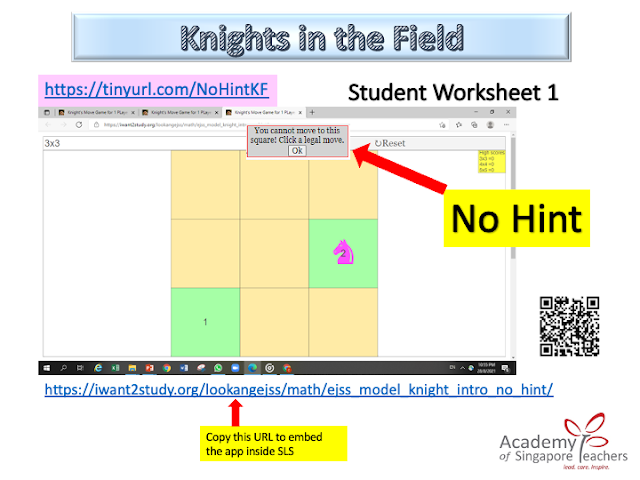 |
||
| https://tinyurl.com/NoHintKF |
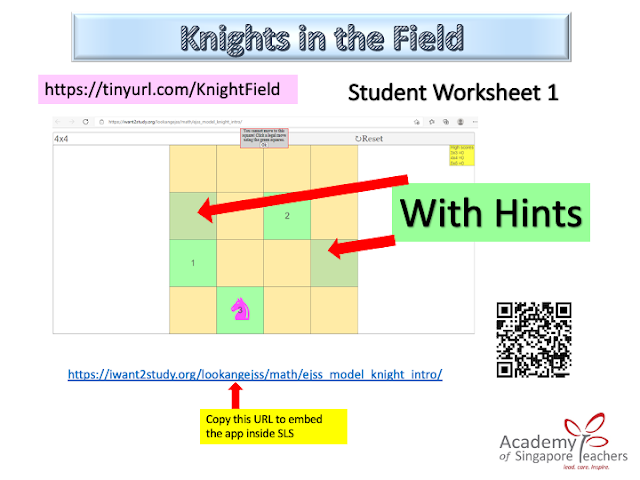 |
| https://tinyurl.com/KnightField |
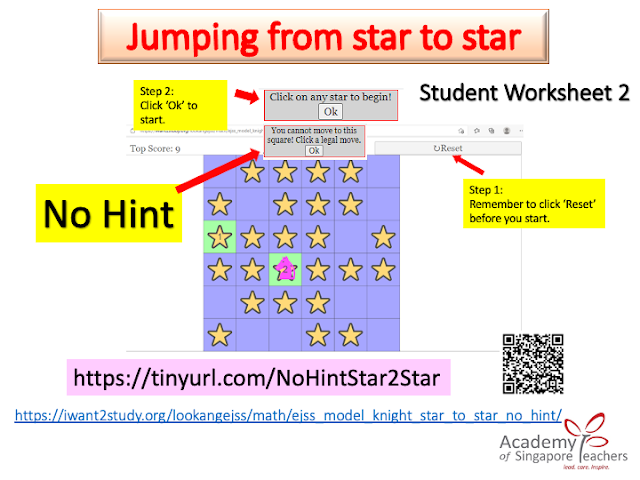 |
| https://tinyurl.com/NoHintStar2Star |
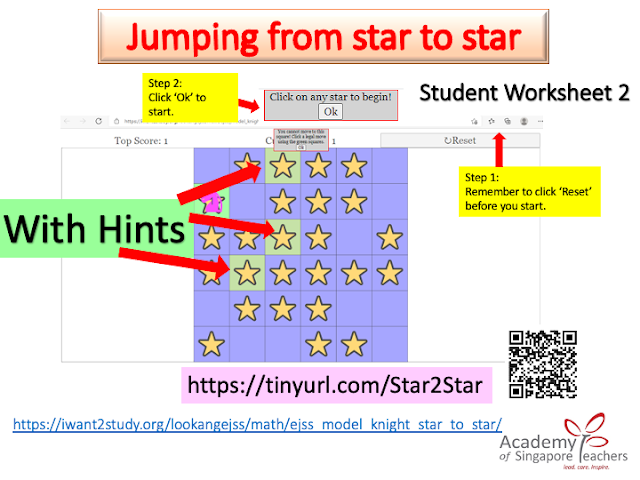 |
| https://tinyurl.com/Star2Star |
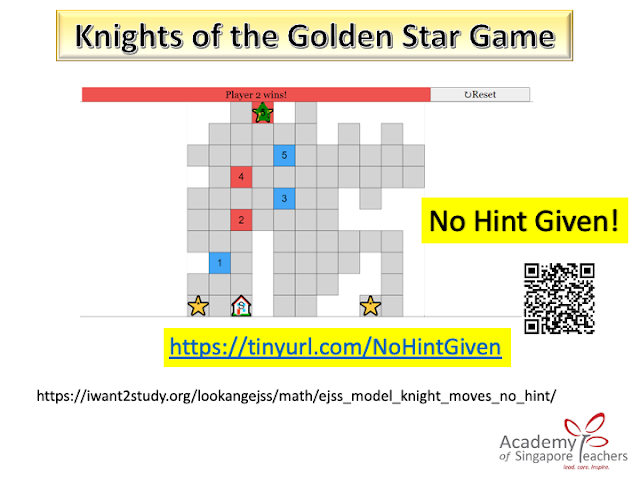 |
| https://tinyurl.com/NoHintGiven |
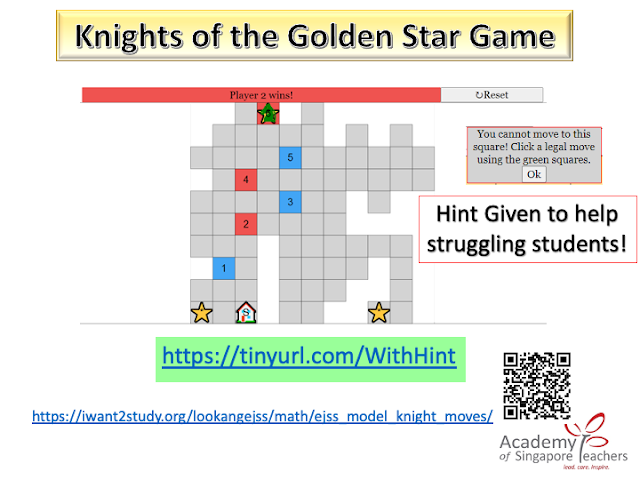 |
| https://tinyurl.com/WithHint |
https://weelookang.blogspot.com/2021/08/20210830-digitale2kapplications-knights.html
Frequently Asked Questions about Open Educational Resources / Open Source Physics @ Singapore
1. What is the primary focus of the "Open Educational Resources / Open Source Physics @ Singapore" initiative? This initiative centers on providing a wide range of freely accessible and interactive educational resources, particularly in physics and mathematics, for various educational levels, primarily focusing on primary and secondary education in Singapore. It leverages open educational resources (OER) and open-source tools to create engaging learning experiences.
2. Who are the key developers and collaborators involved in this initiative? Key individuals involved include Ms Theresa Heng from AST/MTT and Mr Lawrence Wee Loo Kang from ETD/Lead Specialist. The initiative also appears to involve collaborations with organizations like the MOE CPDD Science Unit and contributions from various educators who share their interactive resources and pedagogical approaches.
3. What types of educational resources are offered through this platform? The platform offers a diverse collection of interactive simulations, applets, games, and virtual labs covering topics in Newtonian mechanics, gravity, quantum physics, mathematics (including fractions, geometry, and number properties), and other science subjects like heat, light, and electromagnetism. These resources often utilize HTML5 and JavaScript for broad accessibility.
4. What are some examples of specific interactive resources available? Examples include a Gravitational Field JavaScript applet, a Knight's Tour game (with variations), simulations for multiple slit diffraction, rotational pendulum, projectile motion, balancing beams, chemical bonding, electromagnetism, and even games for learning mathematics and Malay language. There are also tools for visualizing abstract concepts like rational and irrational numbers and ODEs.
5. For which educational levels are these resources primarily designed? While some resources cater to higher levels (e.g., A Level Chemical Bonding), the majority appear to be designed for primary and lower secondary levels, with specific resources mentioned for Primary 1 mathematics and science. The inclusion of topics like basic shapes, counting money, and telling time supports this focus.
6. What tools and technologies are commonly used to create these interactive resources? Many of the interactive elements are built using JavaScript and HTML5, making them accessible through web browsers without the need for additional plugins. The platform also mentions the use of Easy Java/JavaScript Simulations (EJS) Toolkit, Scratch, Flippity, and increasingly, the exploration of AI tools like Google Gemini Pro for content creation and pedagogical applications.
7. How does this initiative promote open education and collaboration? By providing resources under a Creative Commons Attribution-Share Alike license, the initiative encourages the free use, adaptation, and sharing of educational materials. The involvement of multiple educators sharing their creations and pedagogical approaches highlights a collaborative spirit within the Singaporean educational community.
8. Are there any notable themes or emerging trends evident in the recent additions to the platform? Recent additions suggest a growing interest in incorporating game-based learning (e.g., various math and language games), utilizing AI tools for content generation and interactive design, and creating resources that align with the Singapore Student Learning Space (SLS). There's also a focus on virtual labs and simulations to enhance practical learning in science and mathematics.



